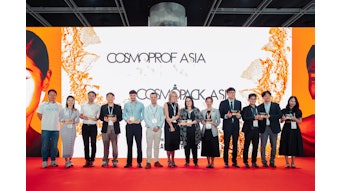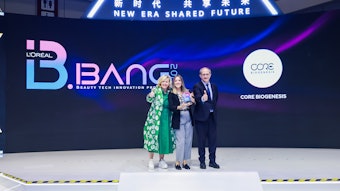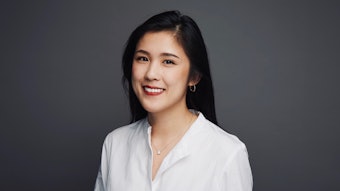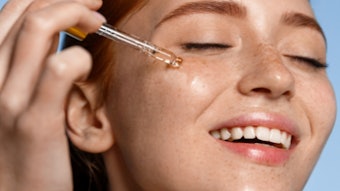The Society of Cosmetic Chemists (SCC) Annual Scientific Seminar, held May 3–June 1, 2012, was led with a charge for sustainability and greener chemistry. Michael Fevola, PhD, of Johnson & Johnson, moderated the first session, which opened with the Henry Maso keynote award lecture given by John Warner, PhD, of the Warner Babcock Institute for Green Chemistry LLC. Warner painted a picture for attendees of a "world where all segments of society demand environmentally benign products," conceding that the reality is today's knowledge of material science would not support this demand. Warner explained that materials can be designed to have a minimal impact on the environment and human health while remaining economically competitive. However, the missing link in current material science studies is an understanding of toxicity and the environmental impact of materials. Looking ahead to predict future opportunities in green chemistry, Warner noted considerations for the environment and cost constraints. Attendees enjoyed this view of a trend already in motion within the personal care industry.
Camille Sasik, PhD, of Aveda, described the development of a sensory test method for identifying sustainable polymers to replace synthetic polymers in hair styling applications. She explained that synthetic polymers generally are not sustainable, renewable or biodegradable, which is why there is a push for their replacement. Sasik’s method combined swatch testing, sensory evaluations and polymer characterization to allow for direct comparisons between synthetic and sustainable polymers. This approach has been used to successfully identify more than 24 naturally derived polymer alternatives. Characterization was carried out by incorporating the polymer of interest in an aqueous gel and assessing parameters including shine, natural feel, flaking and hold. Sasik concluded that sensory testing such as this can be used in the early stages of product development to assist in ingredient replacement.
Tom Burns of Novozymes described the American Chemical Society's Green Chemistry Institute (GCI) round table, a group of companies that are dedicated to develop ingredients as green as possible, to assist formulators in creating more sustainable formulas.
Presenting on behalf of Robert Peoples, PhD, David Wylie discussed the new American National Standards Institute (ANSI) standard for greener formulations. This tool is the result of a collaboration between NSF International and ASC/GCI. The standard is meant to serve as a tool to assist chemists in evaluating the impact of chemicals, processes and the design of new molecules within a health safety framework. According to Peoples and Wylie, “This standard will play a role in transforming chemistry from being petroleum-based to one driven by the ‘Twelve Principles of Green Chemistry.’”
Up-and-coming Research
Throughout the day, attendees had time to peruse the student posters. Research topics included: DEET encapsulation to reduce its absorption into skin, characterizing ion transport in the human nail plate, high throughput methods for in vitro sunscreen testing, the effect of polymer backbone rigidity and hydrophilicity on polymer-surfactant interactions, the influence of alkyl sulfate on the mesomorphic phase behavior of aqueous systems containing fatty acids and their salts and the use of contact angle and surface tension measurements to design oil dispersants. Also from the student posters, foam stability was a major area of study. Posters presentations examined the effects of polyvinylpyrrolidone (PVP) above and below the critical overlap concentration on sodium alkyl ether sulfate foam stability, the effects of polyquaternium-10 on the foam stability of sodium alkyl ether sulfate and sodium alkyl ether sulfate/cocamidobetaine systems and the effects of polyquaternium-10 and ionic strength on the foam stability of sodium alkyl ether sufate and sodium alkyl ether sulfate/cocamidobetaine systems.
Awards Luncheon
During the awards luncheon, Ram Ramaprasad, PhD, of TRI/Princeton, received the SCC's Award for the best paper presented at the 2011 Annual Scientific Meeting, titled, "An Alternative Method for Reshaping Hair." Ramaprasad thanked the society for recognizing his work, as well as his wife for her continued support during his travels from continent to continent. In addition, David Steinberg presented the Henry Maso Keynote Award to Warner for his paper on green chemistry. Regarding the award, Steinberg elaborated, “We learned something from Henry, he didn’t just talk about his accomplishments, and today we learned from this presentation—one of the best I have heard.” Accepting the award, Warner simply thanked the society, adding briefly “You heard enough from me earlier,” referring to his presentation.
Skin and Barrier Protection
The afternoon session, moderated by Karl Lintner, PhD, of KAL’idees, considered the skin and skin barrier and various approaches for studying it. Ingo Schellenberg, PhD, of the Anhalt University of Applied Sciences, described a method to chromatographically separate lipid substances of the stratum corneum (SC) and lipids in cosmetics. This method utilizes high performance thin layer chromatography (HPTLC) combined with TLC-MS (mass spectrometry) in an automated multiple development (AMD) approach to quantify and qualify samples over a wide range of polarities. Linter observed, “This paper benefits the greater scientific community. It is very interesting for skin barrier studies, and analytical chemists can use it as well,” said Lintner.
During the question and answer session, SCC president Joseph Dallal, of Ashland Specialty Ingredients, joked, “Aren’t you embarrassed to show us this quick and efficient method, considering it has taken us years to perform such studies?” The audience laughed in response.
Following Schellenberg, Isabelle Imbert, PhD, also of Ashland, presented work assessing three biological pathways essential to skin barrier permeability, function and recovery. Two natural compounds were evaluated for their effects on cholesterol synthesis; activation of caspase-14, which is activated during terminal differentiation in the epidermis; and modulation of transglutaminases, involved in the formation of the cornified envelope. The compounds in question were found to affect these pathways, suggesting potential application in products for aged skin with reduced lipid synthesis, UV protection and DNA repair capacities. Her work also emphasized the role of lipid homeostasis in skin functioning.
Next up was Smitha Rao of Lonza, who described the production of extracts via a process that elicits a competitive-type response within the microbes used for fermentation. The extracts were designed to provide natural, safe and non-irritating topical treatments for enhancing skin barrier formation and repairing wounds, and were found to increase the expression of the biological markers hyaluronic acid and caspase-14, which are critical for effective barrier function on a cellular level. A 2% extract significantly accelerated the barrier development of wounded skin.
The last presentation of the day was given by Russel Walters, PhD, of Johnson & Johnson, who detailed a vibrational spectroscopy system to map sodium dodecyl sulfate (SDS) and its permeation and interaction with the skin. Raman spectroscopy and infrared imaging successfully tracked SDS across different regions of the skin and revealed a surprising change in concentration in the viable epidermis boundary, which may be due to solubility. The overall goal of his work was to develop surfactants that are milder by changing their dynamics to keep them on the skin rather than allowing them into the skin. After a day full day of scientific insights, the conference adjourned for a networking cocktail reception and dinner, including fresh shrimp cocktail—a Charleston favorite.
Molecular Skin Biology
The second day of event was led by Howard Epstein, PhD, of EMD Chemicals, who moderated the session on molecular biology of the skin. Presenting first was Philip Ludwig of Lonza, who described work using red rice meristem cultures to promote skin rejuvenation at the epigenetic, protein and macro level. The cultures are grown in bioreactors in a sustainable process to reduce biomass waste. Tests showed the ingredient imparted a dose-dependent increase in skin hydration, barrier function and pore size reduction. This technology was recognized by Cosmetics & Toiletries as a finalist for its 2012 R&D Awards.
Following Ludwig was Sandy Dumont, PhD, of Seppic, with a presentation on the effect of xylityl glucoside (XG) on the expression of barrier function-related genes and moisturization-related proteins. Results, as shown by quantitative reverse transcription (qRT) polymerase chain reaction (PCR) analysis, confirmed that XG can regulate both genes and proteins involved in the epidermal differentiation process.
Rounding out the session was a presentation by Lintner considering the potential to inhibit and reverse glycation and glycotoxins in skin. He presented research on a plant extract of Albizia julibrissin, known as “night sleeper” in Persia, which was found to inhibit the glycation of bovine serum albumin by nearly 50%. In vivo studies of the extract also showed its ability to fight the visible signs of fatigue, including baggy eyes, dark circles and drawn faces.
Poster Winners
The last day’s luncheon was led by Dallal, who gave a “hat’s off” to the presenters. He said, “We’ve really learned something, and it’s nice to see and meet the presenters as well as hear questions from the audience,” which he noted is a downfall of watching webinars rather than real participation. He added that the talks grouped on similar subjects help researchers with their “Ah-ha!” moment—and that research is happening so quickly that even his work from the past 30 years rarely shows up in literature searches.
Dan Roman of D-D Chemco, sponsor of the poster awards, then presented the winning posters, as selected by the SCC Committee on Scientific Affairs. In fourth place were Vipul Padman and Bob Lochhead, PhD, from the University of Southern Mississippi, for studying the effect of backbone rigidity and hydrophilicity on polymer-surfactant interactions. Third place went to Jennifer Karr and Gerald Hasting, PhD, of the University of Cincinnati, for work on DEET encapsulation to reduce its absorption. Second place went to Sudhir Baswan et al., also from the University of Cincinnati, for the characterization of ion transport in the human nail plate. First place was awarded to Andrew Adams, Lisa Kemp and Lochhead, of the University of Southern Mississippi, for their poster on using contact angle and surface tension measurements to design oil dispersants.
The luncheon ended with a song, as it was a special birthday celebration for past president Gary Agisim of Pfizer Consumer Healthcare.
Formulation Feats
The last session of the event focused on new aspects of formulation work. Moderated by Jennifer Marsh, PhD, of Procter & Gamble, the talks opened with Jennifer Kravchenko, of Clariant Corp., on approaches to put some excitement into hand sanitizers via desirable aesthetics and benefits. She described the application of pearlescent effects, benzalkonium chloride in silicone-based formulations for improved stability and a surfactant-free benzalkonium chloride foaming hand sanitizer based on PEG, for mild cleansing.
Next was Jurgen Meyer, PhD, of Evonik Industries, who explained the influence of emulsifiers, emollients and additives on lamellar phases in emulsions. Neutron scattering, among other techniques, was used to examine the bilayer structures and showed that o/w creams stabilized by combinations of emulsifiers and consistency enhancers consist of oil droplets and liquid crystalline bilayer structures in the aqueous phase—vesicles. These creams are not thickened purely by the presence of liquid crystalline bilayer structures in the aqueous phase, and a significant amount of oil is needed to create a cream-like consistency. According to research, now a more realistic model can be proposed for the structure of liquid crystalline phases in o/w emulsions to better predict the influence of various ingredients on emulsion properties. Meyer noted, “[To conduct this work properly], you really have to look at electron microscopy with experts to interpret the images.” This presentation drew great interest from attendees.
Irwin Palefsy, of Cosmetech Labs, suggested, in relation to small variations in the work, “You may possibly be getting bilayer and multilamellar formation, and this could be the reason for the variations.” Also, Lochhead remarked, “This is right on the cusp of what’s going on in emulsion science right now.”
Jeff Seidling of Kimberly-Clark Corp. was next, and he described the development of a novel, soothing tissue incorporating phase-change materials. His presentation went through the steps of the development process, including how the ingredients were chosen and applied to this substrate. This technology also was recognized by Cosmetics & Toiletries as a finalist for the 2012 R&D Awards. Attendees were curious as to whether the specifications on raw materials for this application were tighter than typical, to which Seidling replied there was a specific “sweet spot” for the best results. Also, a question came up of whether the absorbency of the treated tissue was compromised, and Seidling replied, “It’s the same as for current tissues.” In a semi-rhetorical manner, Randy Wickett, PhD, of the University of Cincinnati, wondered, “How do you measure TEWL on the nose?”
In the final presentation of the event, Agisim spoke on a new approach to lip balm sunscreen formulation, focused on flavor. The goal of his team’s work was to develop a lip balm stick providing high UVA and UVB protection using a taste-masking technology to improve organoleptic properties. His solution applied multiple sunscreens with avobenzone and a sorbitol spider ester, sorbeth-2-hexaoleate, with a photostabilizer. Efficient taste-masking of the organic sunscreens was achieved by the spider ester when it was applied at approximately 0.6–2.0% w/w. Further, pre-mixing the ester with the sunscreens produces a complex that is stable at ambient temperatures but can be separated when heated to > 100°C. During the question/answer session, Kevin Tibbs of Better Life asked, “With use of the spider ester, did you look at the efficiency of the SPF?” Agisim responded, “There was no effect on UVA/UVB absorbance.”
In closing, Agisim and Dallal reminded attendees that “SCC means ‘Science Continues at the Company,’” and encouraged attendees to share what they learned when they return to the office, to encourage attendance as well as build upon the science presented. The last of the mid-year SCC Annual Scientific Seminars will be held in St. Louis, Mo., USA, on June 6–7, 2013. Since it is “the last hurrah,” strong attendance and participation are expected. To learn more, visit www.scconline.org.










